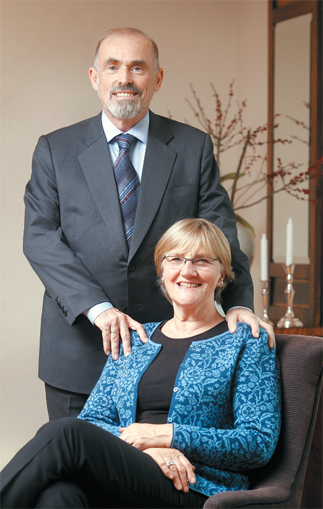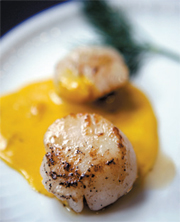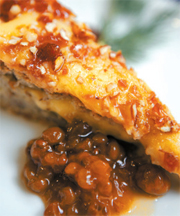[Kitchen talk]Celestial cake and juicy berries

Ambassador Didrik Tonseth and his wife Bjorg Skorstad at their residence where we sampled the delights of cloudberries and homemade cake. By Jeong Chi-ho
How should I describe it? Let’s put it this way: It’s safe to say that the ambassador is set for life.
No, I am not talking about his law degree that he could use in case he gets fired from his job. I’m talking about baked goods as a career. If he opens a bakery, Wall Street will scream for it to go public. If he sells the recipe, trust funds will be set up for his great grand children.
It’s that good.
But there are other reasons I will remember this visit probably more fondly than others I’ve had in the diplomatic community here. Ambassador Tonseth greeted me promptly wearing an apron as he came out of the kitchen.
I was impressed. We retired to the kitchen where he gave the sauce used for a scallop appetizer a good stir. Ambassador Tonseth tells me that he is inspired by Norwegian cook Eyvind Hellstrom, who is well known for preparing seafood dishes and a continental style. His restaurant in Norway has garnered two stars in the Michelin guide.
“This is going to be good,” I tell myself. Summing up Norwegian cuisine, the ambassador said, “It is very traditional and uses raw material provided by Mother Nature, like grouse, moose and deer. Of course, you have fish such as cod that used to be food for the poor people but today it’s recognized by everyone as a delicacy.”

The scallop appetizer.
The way the ambassador explains his experience with Korean cuisine in his two years here proves he is an avid lover of food. “I am not ashamed to say that it took me a few months to get used to Korean food including kimchi. It was very hot. I used to be reluctant to eat spicy food. But kimchi provides contrast with the main dish, which is something I look for when I cook,” he said.

The ambassador’s unique home-made cake.
Topped with cheese, the dish resembled lasagna. It was served with linie aquavit, a potato-based liquor that came with the main meal. It was quite strong, close to vodka, but there was something else in the aftertaste that I could not place. “Caraway seeds and sherry,” Ambassador Tonseth informed me. I am no heavy drinker but this potato spirit went well with the rich meal.
Making the drink is no easy task. According to tradition, the liquor spends four months tooling up and down the Atlantic and Pacific on the deck of a ship, crossing the equator twice and mellowing as it bakes inside old sherry casks, a process that gives the drink its distinctive color and aroma. “Normally, we would drink red wine with our meal, just like in Spain or Portugal, but today is special,” the ambassador said.
As demonstrated, Norwegian cuisine draws on its abundant fish reserves. The country is consistently ranked as one of the top three seafood exporters in the world. One thing that struck me is how the cod is prepared. The fish are hung out to dry in the sun and wind or dried over rocks. Sounds familiar? In Korea, that’s exactly how we prepare myeongtae, the pollack that is so popular here.
The Tonseth cake that came after the baccalau is based on a family recipe that goes back so far that the ambassador can’t even remember its origins. The cake comes with a side dish of cloudberries, which are soft and juicy. They have a slightly sour aftertaste that offsets the dessert’s strong sweet taste and go well with the sprinkling of almonds that lay upon the moist cake. I’ve rarely tasted such a flavorsome combination in a dessert.
The ambassador suggested that the cloudberries also go well with ice cream, but he pointed out that the berries don’t grow in large quantities and sometimes a whole year goes by without them.
This makes me feel great. I now have something with which to impress my high-rolling friends who work at investment banks. The revelation that I have sampled cloudberries should silence them once and for all. Cloudberries should beat six-figure bonuses, right? It will be a whole new day.
“Nice bonus. But have you tried cloudberries? No, you can’t buy them here.” This is going to be really good. I just need to work cloudberry into our conversation. “You bought a house? I had cloudberries.” Don’t know if it’s going to work.
Norway is part of the Scandinavian welfare model that features one of the best social safety nets in the world. It is also a strong advocate of women’s rights. Fittingly, the Norwegian Embassy has sponsored visits by its policy experts and professors on gender policies. One thing the ambassador and his wife Bjorg Skorstad mentioned was how both men and women take time off from work after they have kids. The ambassador said two of his staff were currently on paternity and maternity leave. “This is conducive to having children,” the ambassador said. “We have been telling the Koreans, ‘Unless you do something, your economy will not grow to its potential.’”
Gosh. This reminds me of a recent survey here in which 90 percent of the surveyed people said they don’t make use of leave allocations when they have kids for fear of losing out on a promotion or even getting fired.
I am almost at the end of this column but this is the first time I had time to touch upon anything else, which just goes to show how impressed I was with Tonseth’s love for cooking.
Receptions at the Norwegian residency must be a feast. A host’s passion tends to rub off on the preparations. Close to 50,000 Korean visitors journey to Norway every year. From the taste I got I must say it must be money well spent. For the food alone, plus the promise of what might be there, I am putting Norway on my “to visit” list.
You should do it, too.
By Brian Lee Staff Reporter [africanu@joongang.co.kr]










with the Korea JoongAng Daily
To write comments, please log in to one of the accounts.
Standards Board Policy (0/250자)